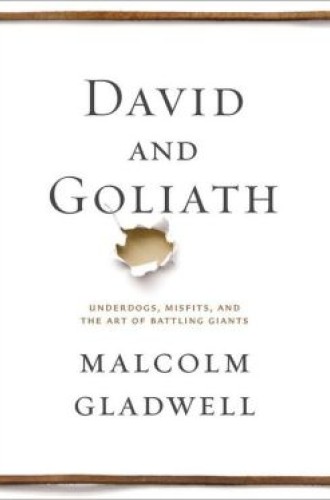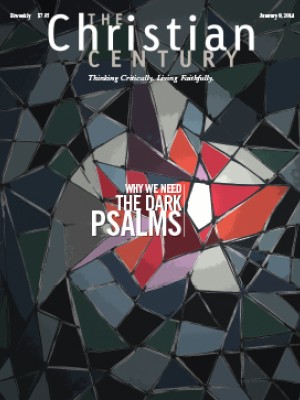David and Goliath, by Malcolm Gladwell
Malcolm Gladwell is a best-selling nonfiction author several times over. A staff reporter for the New Yorker, he was recently cited on Glee—which is to say, he’s a genre-shaping writer with mass appeal, as well as a journalist whose work is more popular and trusted than that of many social scientists working in the United States today. He’s also a Christian.
I’ve been reading Gladwell for years. His 1999 piece “Six Degrees of Lois Weisberg” is a perfect example of why I love his stuff. That story begins with a richly detailed profile of a woman in Chicago, develops into an exploration of how social networks operate, and concludes with an insightful meditation on poverty. The idea came from Gladwell’s personal experience: Lois Weisberg is the mother of one of Gladwell’s college friends. The evolution of the piece from closely observed narrative to theoretical discussion demonstrates his signature, oft-copied style, which now includes a white book cover with the title printed in Caslon, an 18th-century font favored by Ben Franklin. (How’s that for signaling authority and pedigree?)
Read our latest issue or browse back issues.
Gladwell’s new book, David and Goliath: Underdogs, Misfits, and the Art of Battling Giants, is his first that touches on religion, and he credits the process of writing it to his renewed faith. He told Religion News Service that although he never had a singular conversion experience, telling stories of “people in extraordinary circumstances” led to a “slow realization of something incredibly powerful and beautiful in the faith that I grew up with that I was missing.”
I am always happy to hear of others having epiphanies, I am delighted that Gladwell says he plans to find a church community as part of his reentry into Christianity, and I am glad to learn of the positive example set by his family and their Mennonite communities. But I worry a bit that David and Goliath is like Bob Dylan’s Saved, the subpar album released after Dylan’s conversion to Christianity. The craft is there in David and Goliath—the storytelling, the ideas—but something’s changed, and Gladwell knows it. He puts a positive spin on the difference:
This book differs from past books because it’s less about looking at things at a high, theoretical level—what are the principles that govern the way we behave or the way success happens. This book is much more concerned with individuals and the choices they make. Going in that direction makes sense if you’re taking religious perspectives much more seriously.
It’s true: David and Goliath is not organized in the same way as Outliers and Gladwell’s other works. There is an opening, framing story here: Gladwell retells the fateful meeting of the Philistine giant and the boy who would be king and concludes that “the powerful and the strong are not always what they seem.” Following this less than revolutionary proposition, the book is divided into three sections. The first considers “the advantages of disadvantages (and the disadvantages of advantages)”; the second, “the theory of desirable difficulty”; and the third, “the limits of power.”
The stories told in each section vary widely in subject matter and ability to compel the reader. In the first part Gladwell talks about a basketball team full of short kids who learned a new strategy and beat the tall kids. His point is that underdogs can rely on strategy to outsmart “giants,” that not having an obvious advantage seems almost to force thinking outside the box. In this section Gladwell also discusses class size in schools; whether money is good for parenting; and whether Harvard, by only accepting the brightest students and creating a big pond in which small fish flounder, is forcing middling science students into unsatisfying careers in law. If the thread between these myriad topics seems tenuous, even for a master essayist like Gladwell, that was my impression, too.
In the second section, on “desirable difficulty,” readers hear of three men who overcome grave challenges (dyslexia, a terrible childhood, run-ins with segregationist police chief Bull Connor) and went on to orchestrate great, almost miraculous success. Once again, the stories Gladwell tells are interesting—especially that of Jay Freireich, who was one of the first physicians to make progress in treating childhood leukemia—but the stories don’t really support the theory in any incontrovertible way. The ability to make lemonade out of lemons, after all, is important in any human life.
Gladwell is right that recognizing one’s own limitations, whether innate or due to social location, can encourage a willingness to break the rules and play by different ones, to develop other skills and think outside the box. But this argument has been made much better elsewhere: recently, if less entertainingly, in Paul Tough’s How Children Succeed: Grit, Curiosity, and the Hidden Power of Character, and in the critically acclaimed 1996 ethnography In Search of Respect: Selling Crack in El Barrio, by Philippe Bourgois. Bourgois captures the risks of deprivation and exclusion in ways that Gladwell does not. Being an underdog, despite romanticization of the status, is often a double-edged sword.
The third big idea in David and Goliath is the clearest and most interesting: institutions and people in power tend to downplay the importance of fomenting their own legitimacy. Two powerfully wrought examples come from the Troubles in Northern Ireland and from Huguenot resisters to Vichy France. Another chapter tells of the differing responses of two parents who each lost a daughter in a senseless and random murder: the first, in a desire for justice and prevention, helped to bring about the “three strikes and you’re out” sentencing law in California and contributed to the exponential growth of the disenfranchised and prison populations; the second forgave the killer, grieved and moved on. This section demonstrates how authority comes from multiple sources; how bravery and courage, justice and peace, and power and change may not work the way we think they will.
The questions here about institutions, authority, power and change are important for Gladwell’s wide readership, and certainly for the church. It’s good for us to be reminded that there are many gifts but one spirit, and to see how strength can be played out in weakness through the stories of people other than the apostle Paul. But the weakness of this book—which is not a secret strength—lies in Gladwell’s understanding of faith as something that simplifies the explanations we have for things. Even though faith flips our expectations and the stories we tell, we still tend to think that it also demands a clear moral of all our stories.
How does David beat Goliath? According to Gladwell, he’s willing to break the accepted rules of combat and prey upon his opponent’s myriad weaknesses. This reading may give hope to scheming underdogs, but it minimizes the ethical bind of the disadvantaged who are trying to make a way out of no way, as well as the often insurmountable burdens of social isolation and economic deprivation that Gladwell has documented elsewhere.
Gladwell has said that he considers himself a Goliath. This book demonstrates one consistent, if trifling, drawback to being a giant in publishing: after a certain number of best sellers, your editors stop pointing out the holes in your argument.






